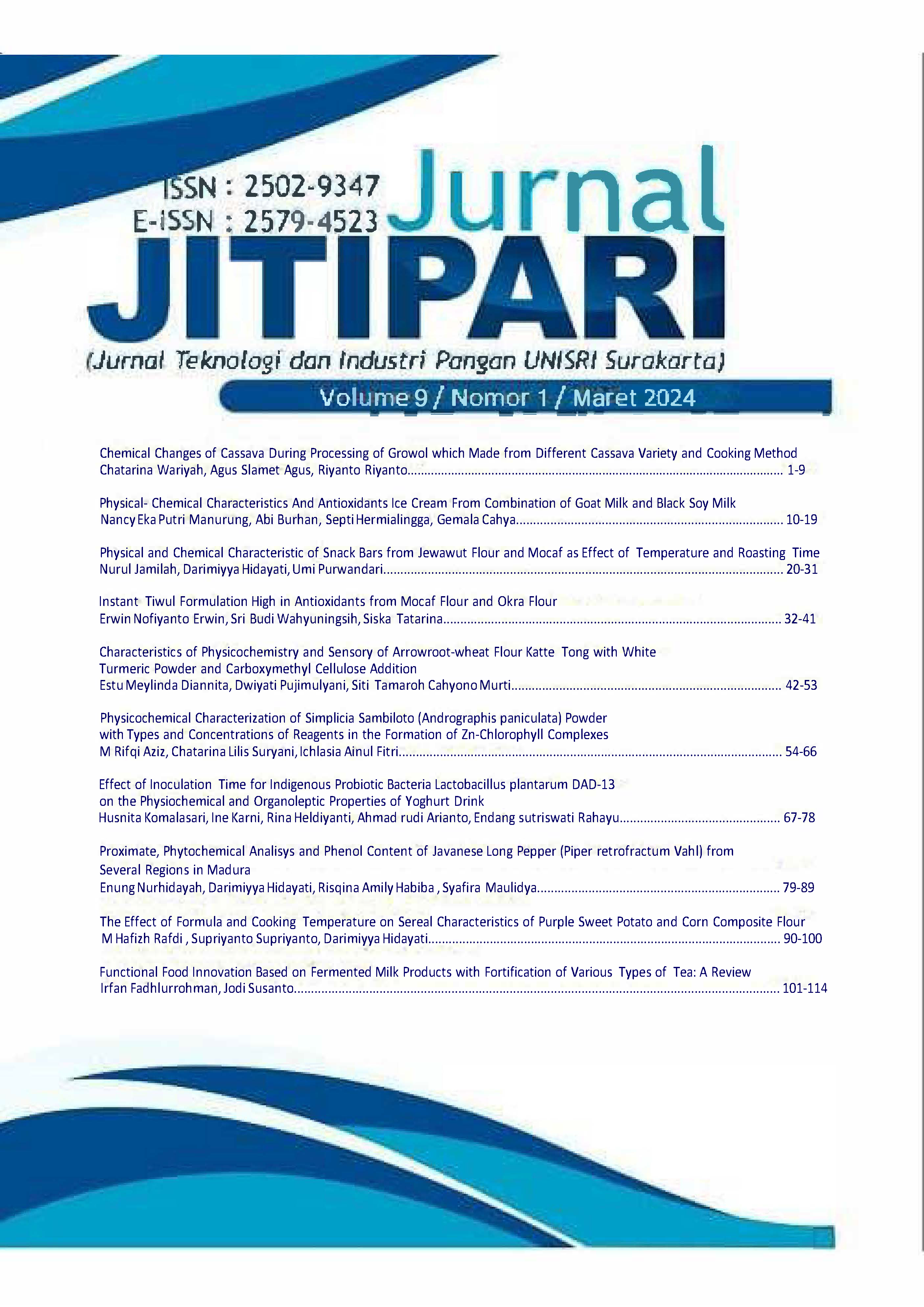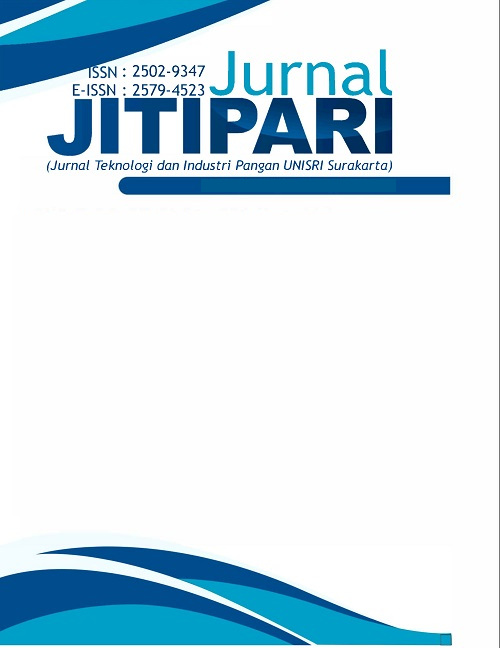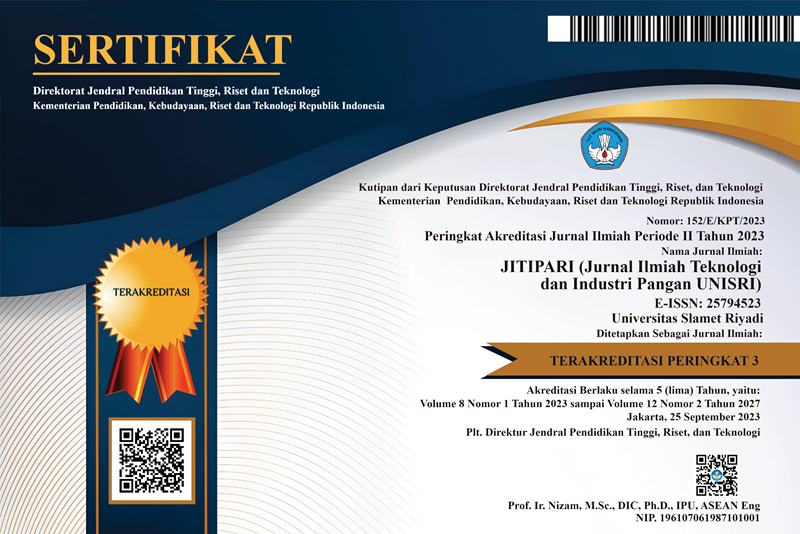Effect of Inoculation Time for Indigenous Probiotic Bacteria Lactobacillus plantarum DAD-13 on the Physiochemical and Organoleptic Properties of Yoghurt Drink
Pengaruh Waktu Inokulasi Bakteri Probiotik Indigenous Lactobacillus plantarum DAD-13 terhadap Sifat Fisikokimia dan Organoleptik Yoghurt Drink
DOI:
https://doi.org/10.33061/jitipari.v9i1.10121Abstract
Yoghurt drink is a product obtained from fermentation of milk by certain lactic acid bacteria. The aim of this research was to determine how the inoculation time of the indigenous probiotic bacteria Lactobacillus plantarum Dad-13 influences the physicochemical and organoleptic properties of functional plain yoghurt probiotic drink products. This research used an experimental method with a completely randomized design with a single factor, 4 treatments and 3 replications. Reaserch data were analyzed using diversity analysis and Duncan's multiple distance test at a significance level of 5% using SPSS and Minitab 17 software. The results showed that the use of probiotic bacteria significantly affected on viscosity, color L*, color a*, color b*, °HUE, pH, total dissolved solid, and fat content, but did not significantly influenced on protein content. The use of probiotics as a starter in yoghurt drinks increased viscosity, color brightness, pH and fat content, and have a lower total dissolved solid. The best treatment in this study was joint-inoculation who had viscosity 290,67 mPa.s; color L* 89,46; color a* 2,92; color b* 1,61; °HUE 29,47; pH 5,00; total dissolved solid 16,67 °brix; fat content 2,34 %; and protein content 4,12%. For the scoring test, this treatment has a non-sour taste; the aroma is slightly sour; Slightly thick texture and homogeneous consistency. Meanwhile, the hedonic test has a neutral taste, aroma and texture as well as a color, appearance and consistency were quite liked by the panelists.
References
Akbar, E. R. M. I. (2016). Pengembangan Probiotik dalam Starter Yoghurt Dengan Variasi Jenis dan Konsentrasi Bakteri Asam Laktat (Streptococcus Thermophilus, Lactobacillus Bulgaricus dan Lactobacillus Plantarum). [Skripsi]. Universitas jember.
Allgeyer, L. C., Miller, M. J., & Lee, S.-Y. (2010). Sensory and microbiological quality of yogurt drinks with prebiotics and probiotics. Journal of Dairy Science, 93(10), 4471–4479. https://doi.org/10.3168/jds.2009-2582
Astuti, A. F., & Wardani, A. K. (2016). Pengaruh Lama Fermentasi Kecap Ampas Tahu Terhadap Kualitas Fisik, Kimia Dan Organoleptik. Jurnal Pangan Dan Agroindustri, 4(1), 72–83.
Bikheet, M. M., Yasien, E. E., & Galal, S. M. (2021). Preparation of Functional Yoghrt Drink Fortified with Moringa olifera Leaves. Journal of Food and Dairy Science, 12(9), 217–223.
Burton, E., Arief, I. I., & Taufik, E. (2014). Formulasi Yoghurt Probiotik Karbonasi Dan Potensi Sifat Fungsionalnya Functional propertties of carbonated probiotic yogurt. Jurnal Ilmu Produksi Dan Teknologi Hasil Peternakan, 2(1), 213-218.
Colakoglu, H., & Gursoy, O. (2011). Effect of lactic adjunct cultures on conjugated linoleic acid (CLA) concentration of yogurt drink. Journal of Food, Agriculture & Environment, 9(1), 60–64.
Degeest, B., & Vuyst. (1999). Indication that the nitrogen source influences both amount and size of exopolysaccharides produced by Streptococcus thermophilus LY03 and modelling of the bacterial growth and exopolysaccharide production in a complex medium. Appl. Environ. Microbiol, 65, 2863–2870.
Karagul-Yüceer, Y., & Drake, M. (2013). Sensory Analysis Of Yogurt. In: White, C.H., Kilara, A., (Eds.). Manufacturing yogurt and fermented milks (3rd ed). John Wiley & Sons. pp. 353-367.
Komalasari, H., & Wahyu Krisna Yoga. (2022). Potensi Bakteri Probiotik Indigenous Lactobacillus Plantarum Dad-13 Sebagai Starter Pada Pembuatan Yoghurt Fungsional: Kajian Pustaka. Food Scientia : Journal of Food Science and Technology, 2(2), 199–217. https://doi.org/10.33830/fsj.v2i2.3694.2022
Lang, F., Wen, J., Wu, Z., Pan, D., & Wang, L. (2022). Evaluation of probiotic yoghurt by the mixed culture with Lactobacillus plantarum A3. Food Science and Human Wellness, 11(2), 323–331. https://doi.org/10.1016/j.fshw.2021.11.006
Manab, A. (2008). Kajian Sifat Fisik Yogurt Selama Penyimpanan Pada Suhu 4oC Physical Properties of Yoghurt During Storage at 4oC. Jurnal Ilmu Dan Teknologi Hasil Ternak, 3(1), 52–58.
Milovanovic, B., Djekic, I., Miocinovic, J., Djordjevic, V., Lorenzo, J. M., Barba, F. J., Mörlein, D., & Tomasevic, I. (2020). What Is the Color of Milk and Dairy Products and How Is It Measured? Foods, 9(11). https://doi.org/10.3390/foods9111629
Pratama, S. H. P. (2016). Potensi Supernatan Yogurt LBA-ST Sebagai Antikanker pada sel HeLa (Cell Line Kanker Serviks) Melalui Penghambatan Ekspresi Matrix Metalloproteinase-2 (MMP-2) Secara In-Vitro [Thesis]. Universitas Brawijaya.
Purwantiningsih, T. I., Bria, M. A. B., & Kia, K. W. (2022a). Levels Protein and Fat of Yoghurt Made of Different Types and Number of Cultures. Journal of Tropical Animal Science and Technology, 4(1), 66–73. https://doi.org/10.32938/jtast.v4i1.967
Purwantiningsih, T. I., Bria, M. A. B., & Kia, K. W. (2022b). Levels Protein and Fat of Yoghurt Made of Different Types and Number of Cultures. Journal of Tropical Animal Science and Technology, 4(1), 66–73. https://doi.org/10.32938/jtast.v4i1.967
Putro, H. S., Rara, F. L., Abharina, R., & Refdinal, N. (2020). Pengaruh Penambahan Bakteri Lactobacillus casei dan Bakteri Zymomonas mobilis terhadap Aktivitas Antioksidan pada Yogurt. Akta Kimindo, 5(1), 22–32.
Quigley, E. M. M. (2020). Nutraceuticals as modulators of gut microbiota: Role in therapy. British Journal of Pharmacology, 177(6), 1351–1362. https://doi.org/10.1111/bph.14902
Rahayuni, A., Isnawati, M., & Yuniarti. (2022). Monograf Formulasi Yoghurt Sinbiotik untuk Peningkatan Short Chain Fatty Acid (SCFA). Penerbit NEM.
Setianto, Y. C., Pramono, Y. B., & Mulyani, S. (2014). Nilai pH, Viskositas, dan Tekstur Yoghurt Drink dengan Penambahan Ekstrak Salak Pondoh (Salacca zalacca). Jurnal Aplikasi Teknologi Pangan, 3(3), 110–113.
Sintasari, R. A., Kusnadi, J., & Ningtyas, D. W. (2014). Pengaruh Penambahan Konsentrasi Susu Skim dan Sukrosa terhadap Karakteristik Minuman Probiotik Sari Beras Merah. Jurnal Pangan Dan Agroindustri, 2(3), 65–75.
Tari, N., Intan, A., Handayani, C. B., & Sudarmi, S. (2016). Potensi Probiotik Indigenus Lactobacillus plantarum Dad 13 Pada Yogurt Dengan Suplementasi Ekstrak Ubi Jalar Ungu Untuk Penurun Diare Dan Radikal Bebas. Jurnal Agritech, 36(01). https://doi.org/10.22146/agritech.10677
Wibawanti, J. M. W., & Rinawidiastuti, R. (2018). Sifat Fisik dan Organoleptik Yogurt Drink Susu Kambing dengan Penambahan Ekstrak Kulit Manggis (Garcinia mangostana L.). Jurnal Ilmu Dan Teknologi Hasil Ternak, 13(1), 27–37. https://doi.org/10.21776/ub.jitek.2018.013.01.3
Wijesinghe, J. A. A. C., Wickramasinghe, I., & Sarananda, K. H. (2016). Modified Kithul (Caryota urens) Flour as a Plant Origin Stabilizing Agent in Drinking Yoghurt. Journal of Food and Agriculture, 9(1–2), 1–13. https://doi.org/10.4038/jfa.v9i1-2.5202
Yang, S.-Y., & Yoon, K.-S. (2022). Effect of Probiotic Lactic Acid Bacteria (LAB) on the Quality and Safety of Greek Yogurt. Foods, 11(23). https://doi.org/10.3390/foods11233799
Zhao, X., & Liang, Q. (2022). EPS-Producing Lactobacillus plantarum MC5 as a Compound Starter Improves Rheology, Texture, and Antioxidant Activity of Yogurt during Storage. Foods, 11(11), 1660. https://doi.org/10.3390/foods11111660
Downloads
Published
How to Cite
Issue
Section
License
Copyright (c) 2024 Husnita Komalasari, Ine Karni, Rina Heldiyanti, Ahmad rudi Arianto, Endang sutriswati Rahayu

This work is licensed under a Creative Commons Attribution-ShareAlike 4.0 International License.
Authors who publish this journal agree to the following terms:
- Authors retain copyright and grant the journal right of first publication with the work simultaneously licensed under a Creative Commons Attribution-ShareAlike 4.0 International (CC BY-SA 4.0) that allows others to share the work with an acknowledgement of the work's authorship and initial publication in this journal.
- Authors can separately make additional contractual arrangements for non-exclusive distribution published by the journal (e.g., publish it in a book), with an acknowledgement of its initial publication in this journal.
- Authors are allowed and encouraged to send their work via online (e.g., in the institutional repositories or their website) after published by the journal.










